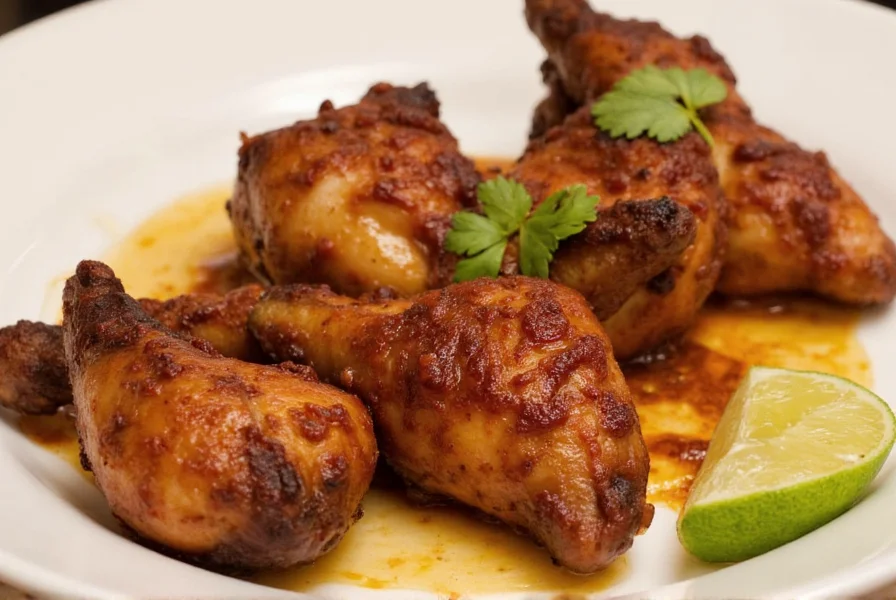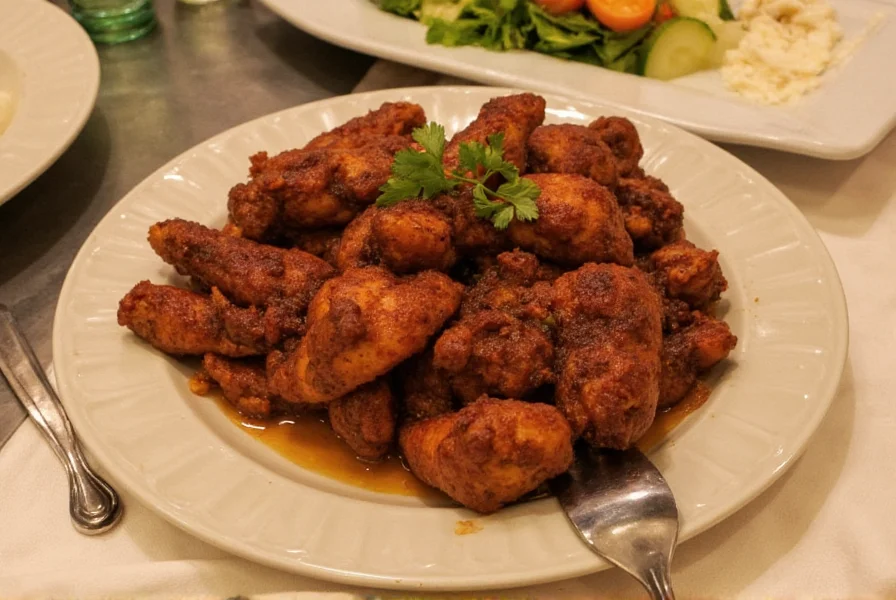Blackened chicken is a popular Cajun cooking technique where chicken is coated in a special spice blend and cooked at high heat to create a flavorful, charred crust. If you've been searching for "blackend chicken" recipes, you've likely encountered confusion - the correct term is "blackened chicken" (with an 'e'). In this comprehensive guide, you'll learn the authentic preparation method, perfect spice ratios, cooking temperatures, and professional tips to create restaurant-quality blackened chicken at home.
Table of Contents
- What Is Blackened Chicken? (And Why "Blackend" Is Incorrect)
- Authentic Blackened Chicken Recipe
- Perfect Spice Blend Ratios
- Professional Cooking Techniques
- 5 Common Mistakes to Avoid
- Serving Suggestions and Pairings
- Frequently Asked Questions
What Is Blackened Chicken? (And Why "Blackend" Is Incorrect)
Blackened chicken is a cooking technique developed by Chef Paul Prudhomme in the 1980s at his New Orleans restaurant, K-Paul's Louisiana Kitchen. The method involves coating chicken in a dry spice mixture, then cooking it in a very hot cast-iron skillet until a dark, flavorful crust forms. Despite common misspellings like "blackend chicken," the correct term is always "blackened chicken" - referring to the darkened (blackened) appearance of the cooked chicken.
The confusion between "blackened" and "blackend" is widespread online, but professional culinary resources consistently use "blackened." Understanding this distinction is crucial for finding authentic recipes and cooking techniques. The blackening process creates a complex flavor profile that's spicy, smoky, and deeply aromatic without being overwhelmingly hot.
Authentic Blackened Chicken Recipe
Here's a professional-grade blackened chicken recipe that yields perfectly cooked results every time. This serves 4 and takes approximately 25 minutes total preparation and cooking time.
Classic Blackened Chicken
Prep time: 10 minutes | Cook time: 6-8 minutes | Total time: 18 minutes
Ingredients
- 4 boneless, skinless chicken breasts (6-8 oz each)
- 3 tbsp blackened seasoning (recipe below)
- 1½ tbsp melted butter or ghee
- 1 tbsp olive oil
- 1 lemon, cut into wedges
Instructions
- Pat chicken breasts completely dry with paper towels - moisture is the enemy of proper blackening
- Heat cast-iron skillet over high heat for 5 minutes until smoking hot
- While skillet heats, coat chicken thoroughly with blackened seasoning on all sides
- Add butter and olive oil to the hot skillet (it should sizzle immediately)
- Carefully place seasoned chicken in skillet, pressing down gently with a spatula
- Cook undisturbed for 3-4 minutes until deeply browned crust forms
- Flip chicken and cook another 3-4 minutes until internal temperature reaches 165°F
- Remove from heat, rest for 5 minutes, then serve with lemon wedges
Pro tip: For restaurant-quality results, chill the seasoned chicken for 30 minutes before cooking to help the spice rub adhere better.
Perfect Spice Blend Ratios
The secret to authentic blackened chicken is the spice blend. Here's the precise ratio used by professional chefs:
| Spice | Measurement | Flavor Contribution | Substitute Option |
|---|---|---|---|
| Paprika | 2 tbsp | Base flavor, color | Smoked paprika for extra depth |
| Garlic powder | 1½ tbsp | Savory base note | 1 tsp fresh minced garlic |
| Onion powder | 1 tbsp | Sweetness, complexity | 1 tsp fresh minced onion |
| Cayenne pepper | 1½ tsp | Heat element | ¼ tsp red pepper flakes |
| Dried thyme | 1 tsp | Earthy herbal note | Oregano (slightly different profile) |
| Black pepper | 1 tsp | Sharpness, complexity | White pepper (milder) |
| Salt | 1 tsp | Flavor enhancer | Sea salt flakes |
Important note: Do not add oil to your spice blend - oil causes the spices to burn before proper blackening occurs. The oil should be in your cooking pan, not in your spice mixture.

Professional Cooking Techniques
Master these techniques to achieve perfect blackened chicken every time:
The Cast-Iron Method (Most Authentic)
Traditional blackened chicken requires a smoking hot cast-iron skillet. The key is proper preheating - your skillet should be hot enough that a drop of water instantly vaporizes. Use a combination of butter (for flavor) and high-smoke-point oil like avocado oil (for stability at high temperatures).
Oven Broiler Method (For Indoor Cooking)
When outdoor grilling isn't possible, use your oven's broiler:
- Preheat broiler on high for 10 minutes
- Place seasoned chicken on a broiler pan 4-6 inches from heating element
- Cook 5-7 minutes per side until internal temperature reaches 165°F
- Rotate pan halfway through for even cooking
Grill Method (For Smoky Flavor)
For authentic smoky flavor:
- Preheat grill to maximum temperature (500°F+)
- Clean and oil grates thoroughly
- Cook chicken directly over flames for 3-4 minutes per side
- Avoid moving chicken until it releases naturally from the grates
5 Common Mistakes to Avoid
- Using wet chicken - Pat chicken completely dry; moisture prevents proper crust formation
- Under-seasoning - Be generous with the spice rub; it should form a visible coating
- Low heat cooking - The skillet must be smoking hot to properly blacken without overcooking
- Moving chicken too soon - Wait until it releases naturally from the cooking surface
- Skipping the resting period - Let chicken rest 5 minutes after cooking for juicier results

Serving Suggestions and Pairings
Blackened chicken pairs beautifully with these complementary sides:
- Creamy accompaniments: Remoulade sauce, avocado crema, or ranch dressing to balance the spice
- Starchy sides: Garlic mashed potatoes, cornbread, or dirty rice
- Fresh elements: Citrus slaw, grilled asparagus, or tomato salad
- Beverage pairings: Crisp lager, citrus-infused water, or sweet iced tea
Nutritional information per serving: 285 calories, 36g protein, 11g fat (3g saturated), 2g carbs, 0g sugar. Blackened chicken is a lean protein option when prepared without excessive oil.
Frequently Asked Questions
What's the difference between blackened chicken and regular grilled chicken?
Blackened chicken features a specific spice crust created through high-heat cooking in a dry skillet, resulting in a dark, flavorful exterior. Regular grilled chicken is typically seasoned more lightly and cooked at moderate temperatures without the distinctive charred crust that defines blackened preparation.
Why is my blackened chicken burning instead of blackening properly?
This usually happens when the skillet isn't hot enough before adding the chicken. Proper blackening requires a smoking hot surface (around 500°F) that immediately sears the spices. If your spices are burning, your heat is too high without proper preheating, or you're using a spice blend with sugar (which burns easily).
How can I make blackened chicken less spicy for kids?
Reduce the cayenne pepper to ¼ tsp or eliminate it completely. Increase the paprika proportionally to maintain the dark color. You can also serve with cooling dips like ranch or yogurt sauce. The blackening technique still works beautifully with mild spice blends.
Can I use this technique with chicken thighs instead of breasts?
Absolutely. Chicken thighs work exceptionally well for blackening due to their higher fat content. Adjust cooking time to 4-5 minutes per side, ensuring internal temperature reaches 175°F for dark meat. The extra fat helps create an even more flavorful crust.
What's the best oil to use for blackening chicken?
Use a combination of 1 part butter (for flavor) and 1 part high-smoke-point oil like avocado oil, grapeseed oil, or ghee. Avoid olive oil for high-heat blackening as it has a lower smoke point. The ideal cooking temperature is 450-500°F.
How do I store and reheat leftover blackened chicken?
Store in an airtight container in the refrigerator for up to 3 days. To reheat without losing the crust, wrap in foil and warm at 350°F for 10-12 minutes, or use an air fryer at 325°F for 5-7 minutes. Never microwave as it destroys the crust texture.
Is blackened chicken the same as Cajun chicken?
While related, they're not identical. Blackened chicken specifically refers to the high-heat cooking technique that creates a charred crust. Cajun chicken uses similar spices but may be grilled, baked, or sautéed without the intense searing process that defines blackening.











 浙公网安备
33010002000092号
浙公网安备
33010002000092号 浙B2-20120091-4
浙B2-20120091-4